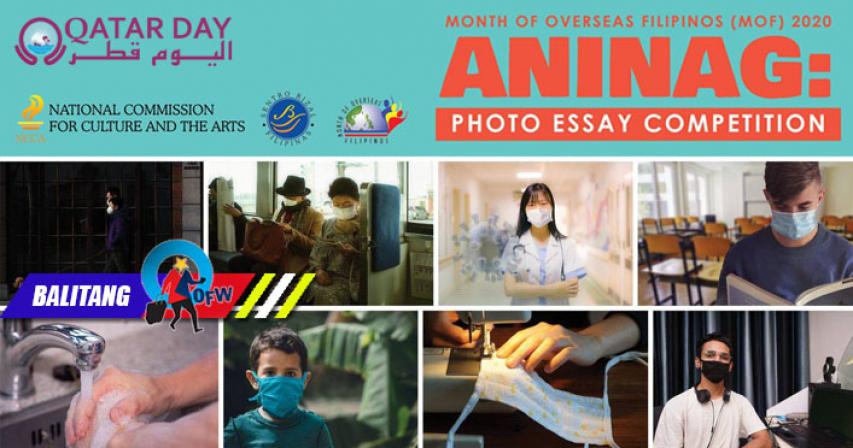Sumali sa 'ANINAG: Photo Essay Contest,' Manalo ng P25k Grand Prize
- 3 years ago

Month of Overseas Filipinos (MOF) 2020 Activity ANINAG: Photo Essay Competition
Sa pagdiriwang ng Month of Overseas Filipinos and International Migrants Day ngayong taong 2020, ang National Commission for Culture and the Arts (NCCA), sa pangunguna ng Sentro Rizal, ay naglunsad ng photo essay competition na may temang: “Pagpupugay sa Migranteng Filipino Tungo sa Pagbangon Mula sa Pandemya.”
Ang ANINAG: Photo Essay Competition ay isang platform para sa Overseas Filipinos (OFs) upang ibahagi ang kanilang skills sa photography at storytelling. Ang photo essay ay nag-uugnay sa dalawang elementong ito, sa pamamagitan ng mga imahe na naghahatid ng mga idea o kuwento. Base sa tema, ang organizing committee ay naghahanap ng photo essays na inilatha ang mga kwento ng mga Pinoy na nasa abroad sa kasagsagan ng COVID-19 pandemic na naging malaki ang epekto ngayong taong 2020.
Paano sumali? Narito ang kabuuang mechanics na nakasaad sa wikang Ingles:
1. The contest is open to all Filipinos and those of Filipino descent, including migrant workers, immigrants, second and third generation Filipinos. Participants must be 15 years old and above and are currently based overseas. Employees and officials of the NCCA and member agencies of the IAC-MOF and their immediate relatives (up to second degree of consanguinity) are not eligible to join the competition.
2. Participants must show proof that they are based overseas upon registration. A copy of any of the following valid documents can be submitted: passport with valid visa, Overseas Employment Certificate, seaman’s book, stamp, alien registration certificate, naturalization papers, etc.
3. Photographs must:
a. have been shot by the participant within the year 2020 and relevant to the MOF 2020 theme.
b. be at least 12MP resolution in JPEG format. Photos taken with phone cameras are allowed as long as they meet this requirement. It is advised that images are taken at the highest resolution possible to ensure maximum optimization for print output. High-quality scans (300 dpi at 8 x 10 inches) of non-digital photographs are also acceptable.
c. NOT violate or infringe upon another person’s copyright.
d. NOT have been part or won any other competition, or offered elsewhere for publication or have been published in magazines and newspapers or have been produced as an advertisement.
e. NOT be altered beyond what is allowed for the contest. Judges reserve the right to disqualify photos if it is determined that a photographer has obviously altered his or her photo beyond what is acceptable. Cropping and minor enhancements are allowed (including spotting, dodging, and burning, contrast and slight color adjustments).
4. Descriptions must:
a. be relevant to the competition theme and complement the photos submitted.
b. be written in English or Filipino. Taglish is not allowed. [updated Nov. 1] c. NOT exceed a total of 250 words. Clear and concise writing is appreciated.
5. An entry must have at least three (3) photos and a maximum of five (5) photos, and a description in the prescribed format. Only one entry is allowed per participant.
6. Participants must register and upload their entry through the following link: https://forms.gle/gPcs32WMYiM1Qcxn9
Kindly upload the following documents when prompted:
a. Proof of being based overseas
b. Photos (compiled in a compressed folder not more than 20 MB) c. Description (.docx format)
d. Signed photo release form (download from bit.ly/aninagphotoessay)
7. Naming convention: All filenames should contain the initial of participants first name and full last name (e.g., jdelacruz_photos.zip, jdelacruz_description.docx). Entries with incomplete details or requirements are automatically disqualified.
8. Entries must be received by the NCCA secretariat not later than 11:59 PHT on November 23, 2020. Announcement of winners will be in December 2020.
9. The NCCA is not responsible for lost, late, misdirected, incomplete, illegible, or otherwise unusable entries, including entries that are corrupted due to computer virus, poor internet connectivity or electronic device problems.
10. Upon submission, participants retain copyrights to their images and text. For winning photos however, authors grant NCCA and the Inter-Agency Committee on the Celebration of Month of Overseas Filipinos (IAC-MOF) permission to use images and text for promoting their programs, the exhibition, and the artist. NCCA and IAC-MOF have the right to publish the winning images and text on their websites, social media channels, and other promotional materials with credit to the author.
11. The winners will be selected by a committee organized by the NCCA and the IAC-MOF, whose decision will be final.
12. The NCCA reserves the right to cancel or modify the competition and award the prize by alternate means if fraud or technical failure is determined at any time by the NCCA, including after the submission window has closed. If the winners are determined to have violated any of the competition rules and guidelines, he/she will be required to forfeit the award and return the prize money, even if the determination was made after it has been awarded.
13. Questions and inquiries may be sent to sentro_rizal@ncca.gov.ph
The registration form, mechanics, and further information on the competition can be accessed through this link: bit.ly/aninagphotoessay.
CRITERIA:
The entries will be judged based on the following criteria:
● Relevance to theme
● Creativity
● Visual impact
● Overall storytelling
PRIZES
● 1st Prize Certificate + Php 25,000 Cash Prize
● 2nd Prize Certificate + Php 20,000 Cash Prize
● 3rd Prize Certificate + Php 15,000 Cash Prize
*subject to applicable Philippine taxes
Winning entries shall be featured in an online exhibit in December, with the possibility of a physical exhibition once circumstances permit in the future.
Basahin din:
Alamin: OFWs, paano makakukuha ng P1M livelihood grant sa OWWA?
Source: National Commission for Culture and the Arts
Comments